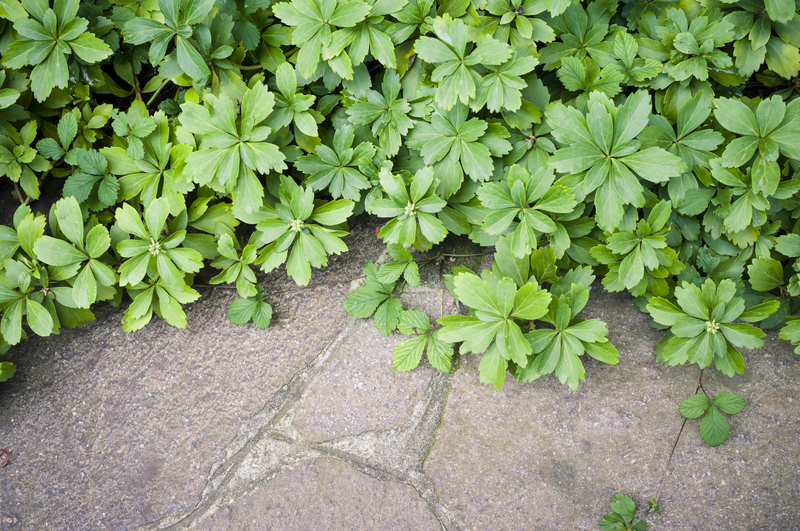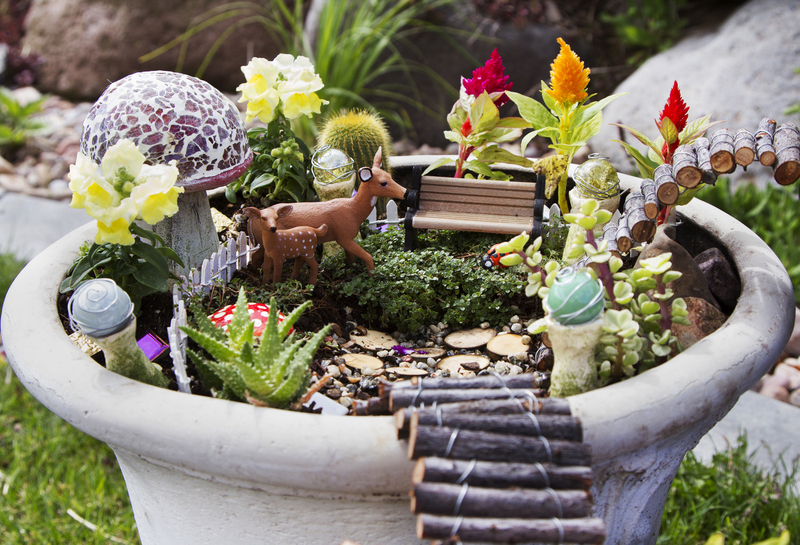Design a Stimulating and Child-Inspired Garden Space
Posted on 02/06/2025
Design a Stimulating and Child-Inspired Garden Space
If you're searching for inspiring ways to nurture creativity, curiosity, and play in your backyard, designing a stimulating and child-inspired garden space is the perfect solution. Gardens not only connect children to nature but also foster their imaginative growth, encourage movement, and provide endless educational opportunities. In this comprehensive and well-structured guide, we'll explore everything you need to know to design an engaging children's garden area that is safe, interactive, and full of wonder.
Why Create a Child-Inspired Garden?
A child-friendly garden is more than an aesthetically pleasing addition to your home; it's a dynamic environment for hands-on learning and open-ended play. Studies show that children who interact with nature develop stronger problem-solving skills, improved attention spans, and enhanced physical health. By cultivating a garden space tailored for kids, you sow the seeds for lifelong appreciation and respect for the outdoors.
- Encourages Exploration: Engaging features stimulate curiosity and imagination.
- Promotes Physical Activity: Natural play spaces encourage movement and healthy growth.
- Boosts Creativity: Diverse gardening elements invite pretend play and artistic expression.
- Environmental Awareness: Early exposure to gardening instills sustainability values.

Planning Your Stimulating Children's Garden
Involve Kids in the Process
Start your garden journey by asking children what excites them. Let them draw ideas, choose favorite colors, and select plants or features they want. Involving children from the outset ensures the space reflects their interests and sense of ownership, making it truly child-inspired.
Assess Your Space
- Sunlight: Note areas with full sun, partial shade, or dense shade.
- Safety: Ensure clear boundaries and consider fencing if necessary.
- Size: Maximize small spaces with vertical gardens or container arrangements.
Establish Zones
Create distinct garden zones for different types of activities: planting beds, play spaces, quiet nooks, and sensory paths. These separate areas promote a stimulating garden environment tailored to various interests.
Incorporating Child-Friendly Design Elements
1. Sensory Gardens
Infuse your garden with elements that engage all five senses. This technique plays a vital role in early childhood development and creates memorable experiences for kids.
- Sight: Bright blooms like sunflowers, calendula, and marigolds add vibrant color.
- Smell: Fragrant herbs--such as lavender, mint, and rosemary--delight the nose.
- Touch: Soft lamb's ear, fuzzy sage, and ornamental grasses invite gentle hands.
- Taste: Edible plants (cherry tomatoes, strawberries, snap peas) make snacking fun.
- Sound: Grasses that rustle in the wind, decorative wind chimes, or water features create soothing sounds.
2. Bold and Creative Pathways
A stimulating, child-inspired garden space should invite discovery. Arrange winding paths using safe materials like wood chips, stepping stones, or painted rocks. Add secret trails or surprise "hideouts" behind tall plants or trellises for adventure.
3. Interactive Play Features
Integrate play spaces that blend seamlessly with the natural environment:
- Climbing structures made from logs, stumps, or repurposed branches.
- Sand pits or mud kitchens for sensory play and tactile exploration.
- Teepees or willow tunnels for imaginative games and quiet retreats.
- Natural balance beams or stepping stones to promote coordination and movement.
4. Grow-to-Eat Plots
A child-inspired garden wouldn't be complete without an area to plant fruits, vegetables, and herbs. Give each child their own plot or container and let them select what to grow. Watching their crops sprout and mature builds patience, pride, and healthy eating habits.
5. Wildlife Havens
Transform your stimulating garden space into a haven for butterflies, bees, birds, and more:
- Butterfly gardens with nectar-rich flowers (milkweed, zinnias, coneflowers)
- Bird feeders, baths, and nesting boxes
- Bug hotels using bamboo, twigs, or pine cones
Observing local wildlife firsthand inspires curiosity and teaches ecology in a hands-on manner.
Choosing the Best Child-Safe Plants
Plant selection is crucial for a safe, child-friendly garden. Choose non-toxic, hardy varieties that can tolerate play and don't have sharp thorns or irritating sap.
- Sunflowers: Fast-growing, visually impressive, and excellent for pollinators.
- Nasturtiums: Edible leaves and flowers add color and flavor to salads.
- Pumpkins and squash: Fun to watch grow and harvest for autumn crafts.
- Herbs: Mint, basil, thyme--perfect for touch, taste, and scent exploration.
- Wildflowers: Easy care, attract pollinators, and provide materials for crafts.
Check local lists or consult with garden centers to avoid toxic plants such as foxglove, lily of the valley, or oleander.
Maximizing Educational Value
A well-designed, stimulating garden space can double as an outdoor classroom. From observing pollinators to charting growth in a scrapbook, the educational opportunities are boundless.
Science and Nature Activities
- Bug Hunts: Equip children with magnifying glasses and bug viewers for hands-on exploration.
- Weather Monitoring: Install a simple rain gauge or wind sock and record daily changes.
- Garden Journals: Encourage children to document plant progress, wildlife sightings, or seasonal changes through drawings and notes.
Art and Creativity
- Use harvested flowers for petal pressings or nature-inspired collages.
- Build scarecrows, fairy houses, or painted rock trails together.
- Host weaving or sculpture projects using natural materials and vines.
Ensuring Safety in the Child-Friendly Garden
Designing a stimulating and child-inspired garden space should always prioritize safety. Here are key considerations:
- Clear boundaries: Define garden borders with fencing, plants, or decorative edging.
- Safe materials: Choose non-slip pathways and avoid sharp-edged decorations.
- Toy and tool storage: Include a weatherproof box or shed for keeping gardening tools out of reach when not supervised.
- Allergy awareness: Be aware of any plant or insect allergies when choosing garden species.
Maintaining Engagement: All Year-Round Fun
A stimulating children's garden should offer activities throughout all seasons, not just in summer. Integrate planning for off-season interest:
- Winter: Evergreen shrubs and bird feeders keep the garden lively, while decorated bare branches add visual appeal.
- Spring: Bulbs like crocus and daffodils provide early color and signs of renewal.
- Summer: Splash zones, shade tents, and sunflowers keep the garden vibrant.
- Autumn: Leaf piles, pumpkin harvests, and seed collecting extend the fun.
Easy Tips to Get Started
- Start small: Even a few planters or a mini raised bed can ignite a passion for gardening in young kids.
- Mix ages: Adapt your garden zones so toddlers, preschoolers, and older children can all participate safely.
- Keep it low maintenance: Choose hardy, native plants and use mulch to reduce weeding.
- Rotate features: Refresh the space each year by adding new plants, decorations, or play structures to sustain excitement.
Inspiration: Themed Kids' Garden Ideas
Take your child-inspired garden design a step further with creative themes:
- Fairy or Gnome Garden: Tuck tiny doors, mushroom seats, and miniature houses amid flowers for magical play.
- Bug Hotel Corner: Invite pollinators and create a science observation station.
- Dinosaur Dig Site: Set up a sandbox with "fossils" to uncover and identify.
- Music Garden: Hang chimes or create drum stations from old pots and pans.
- Edible Rainbow Patch: Plant rows of colorful vegetables and teach about healthy eating in a vibrant display.

Frequently Asked Questions About Child-Friendly Garden Spaces
How do I keep my kids safe in the garden?
Supervision, clear garden boundaries, safe tools, and nontoxic plants are essential. Install gates or fences as needed and educate children about outdoor safety rules.
What if I have limited outdoor space?
Use window boxes, vertical planters, or even a patio container to create a stimulating garden environment. Let kids help decorate pots and design their mini plots.
Do I need expensive equipment or materials?
No! Natural materials like logs, stones, and recycled items make excellent play features. Get creative with what you have and involve kids in the DIY aspect.
Conclusion: Nurture Growth, Play, and Wonder
A thoughtfully designed, child-inspired garden space is truly a gift for growing minds and bodies. By blending natural beauty, play features, and learning opportunities, you create a magical environment where children can laugh, learn, and thrive. Whether you start with a few pots on your balcony or transform a backyard corner into a sensory paradise, the benefits of a stimulating children's garden will bloom for years to come.
Ready to plant the seeds of adventure? Gather your materials, invite little hands to help, and begin creating a unique garden space that will inspire lifelong connections with nature and outdoor play!

